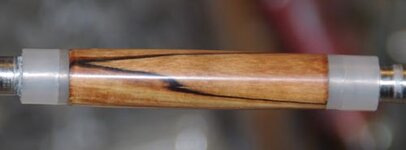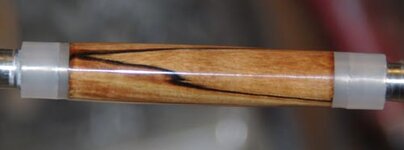Well, someone once said to me, "don't answer a question with another question" but, I'm intrigued about the bushes you have used what are they...???
Now in relation to the CA finish, the first thing I notice is the very irregular edges between the wood and the bushings, secondly I see a very poor finish on the ends of the barrels, scratches and rings, this means that before you started using the CA, the wood was not properly sanded (finished).
With 9 coats of CA (5xthin, 4xmedium) the finish should be a lot better, with more depth..! now, are you sanding in between costs or did you sand somewhere while coating the blank with CA...??? it really looks that half of the CA you put on it has been sanded off and certainly not enough CA in some spots where it show a dull finish.
The last 2 pics are an improvement of the CA finish and those 2 steps are necessary to obtain a proper CA finish anyway but still, the amount of CA over the wood is not even, there is some of those duller spots before polishing are the indication that are possibly higher spots where the sanding remove more CA than any other places so, leaving those areas with little CA (protection) and they will never produce an even shine and depth finish.
The starting of the CA application with thin CA, in my view is an excellent "habit" to have, the first coats need to soak in a little into the timber (material) to achieve a good "bonding" strength, all other layers after that will be "protective" layers. Many CA finished pens endup having "separation" due to the thick layers that fails to bond to the material underneath, this will endup in the CA to become "milky" particularly after some time and if dropped and hit in a sharp edge, this will "brake" the CA layers, making the hole finish to fail...!
With an enormous variety of ways to apply a CA finish, no one single system is better or more effective above all the rest, there are far too many "variants" that alter the final results, this is why what works for one person can possibly not work to someone else. Each one of us have to experiment most possibilities and then start to work on the one that produces the most reliable and consistent results for your circumstances and materials used. Some of us reached that equilibrium quit fast, many other struggle with it for a while but, in the end, you always endup with what works for you, if that is consistent with what others do fine, if not, its fine also...!!!:wink:
Cheers
George



